AFE3101 Accounting Theory Workshop 6 - Trimester 1, 2020
VerifiedAdded on 2022/07/29
|5
|825
|14
Homework Assignment
AI Summary
This assignment solution addresses key concepts in Accounting Theory, specifically focusing on Positive Accounting Theory (PAT) and its application to real-world scenarios. The solution explores how PAT explains the selection of accounting policies and predicts market reactions, as well as the role of conservative accounting methods. The assignment also analyzes a case study involving the Colorado Group and debt covenants, examining the perspectives of lenders and management. The solution provides insights into how companies can avoid breaching debt covenants using accruals and other strategies. Furthermore, it discusses the remuneration of key management personnel and its alignment with shareholder interests. The document is contributed by a student and is available on Desklib, a platform offering AI-based study tools.
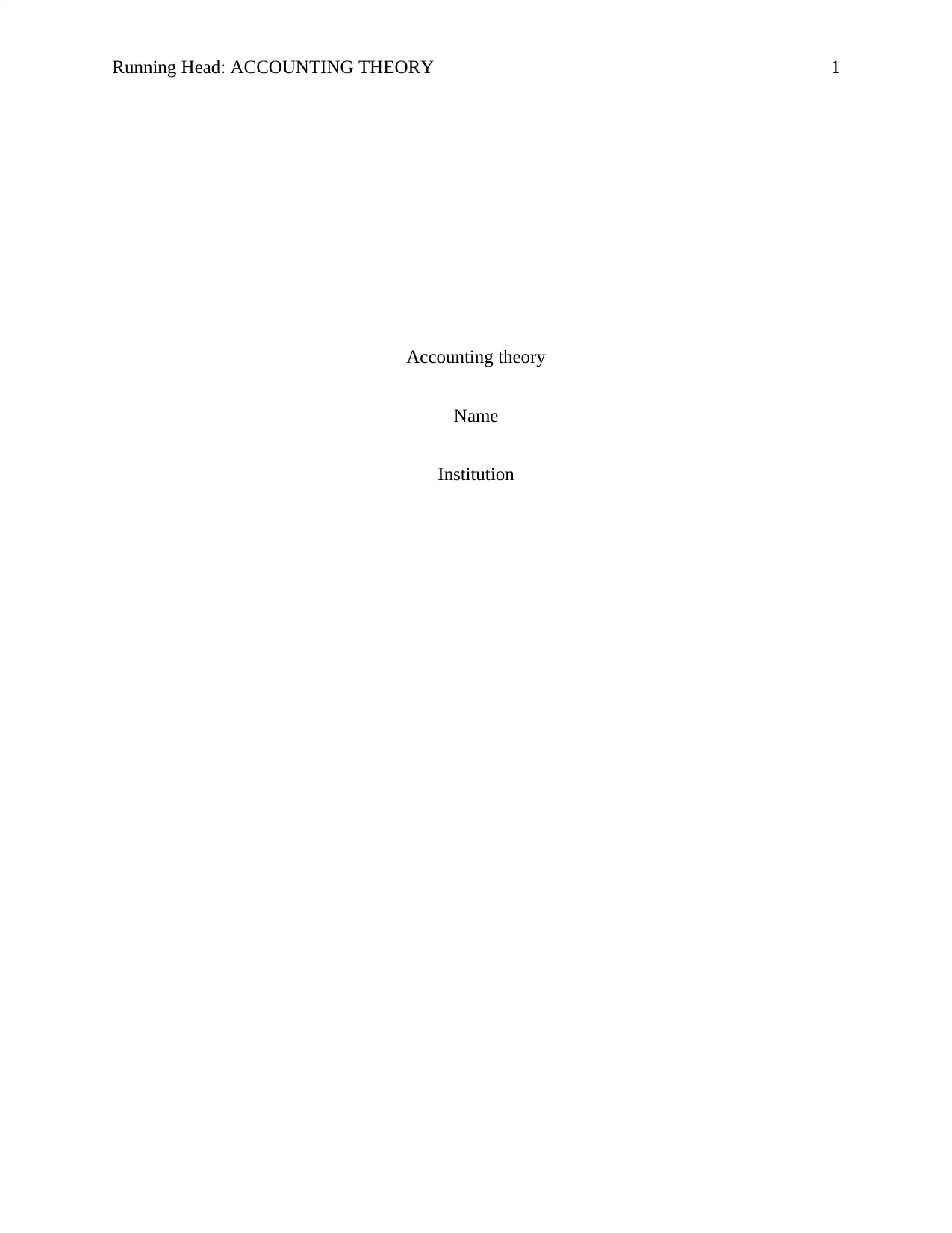
Running Head: ACCOUNTING THEORY 1
Accounting theory
Name
Institution
Accounting theory
Name
Institution
Paraphrase This Document
Need a fresh take? Get an instant paraphrase of this document with our AI Paraphraser
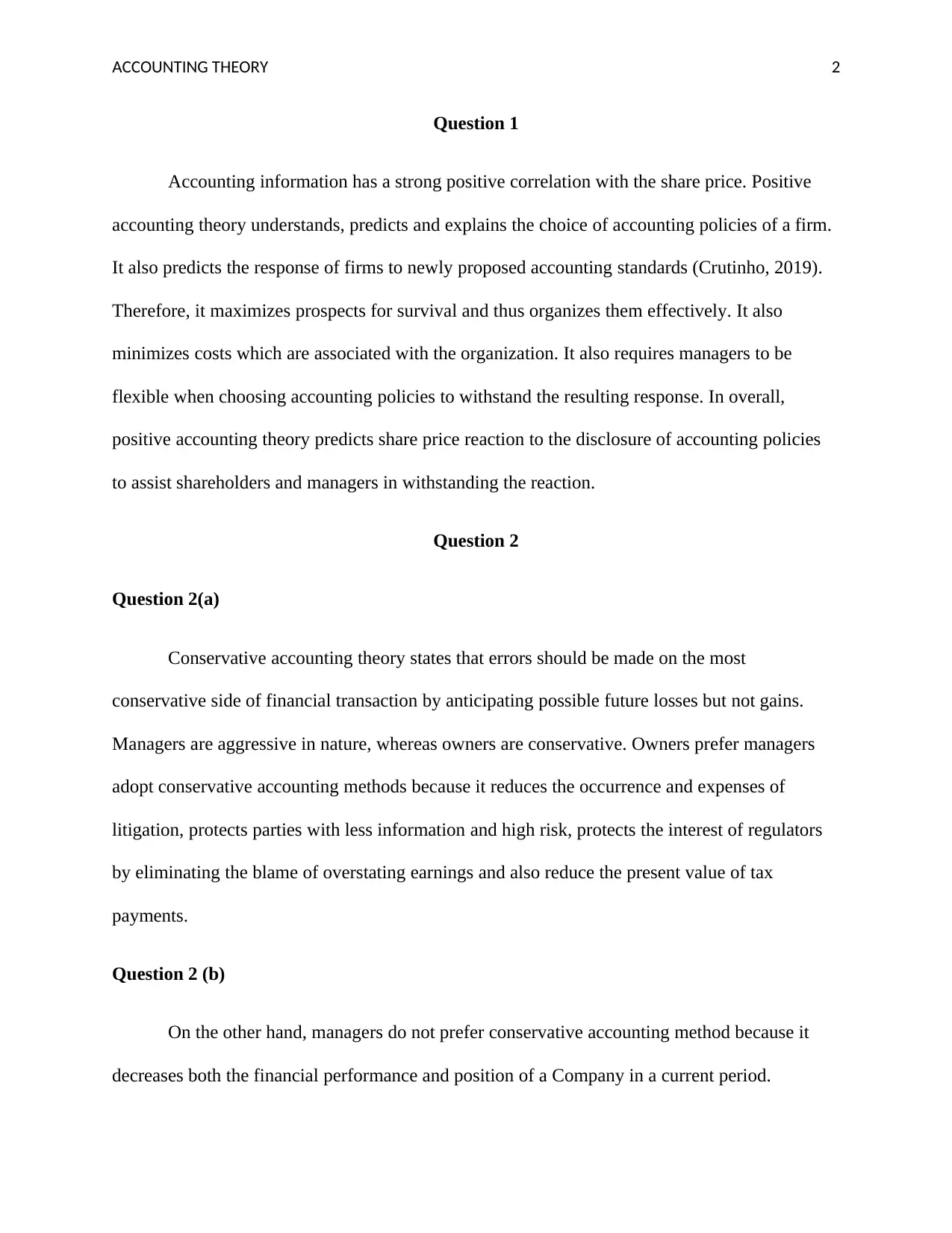
ACCOUNTING THEORY 2
Question 1
Accounting information has a strong positive correlation with the share price. Positive
accounting theory understands, predicts and explains the choice of accounting policies of a firm.
It also predicts the response of firms to newly proposed accounting standards (Crutinho, 2019).
Therefore, it maximizes prospects for survival and thus organizes them effectively. It also
minimizes costs which are associated with the organization. It also requires managers to be
flexible when choosing accounting policies to withstand the resulting response. In overall,
positive accounting theory predicts share price reaction to the disclosure of accounting policies
to assist shareholders and managers in withstanding the reaction.
Question 2
Question 2(a)
Conservative accounting theory states that errors should be made on the most
conservative side of financial transaction by anticipating possible future losses but not gains.
Managers are aggressive in nature, whereas owners are conservative. Owners prefer managers
adopt conservative accounting methods because it reduces the occurrence and expenses of
litigation, protects parties with less information and high risk, protects the interest of regulators
by eliminating the blame of overstating earnings and also reduce the present value of tax
payments.
Question 2 (b)
On the other hand, managers do not prefer conservative accounting method because it
decreases both the financial performance and position of a Company in a current period.
Question 1
Accounting information has a strong positive correlation with the share price. Positive
accounting theory understands, predicts and explains the choice of accounting policies of a firm.
It also predicts the response of firms to newly proposed accounting standards (Crutinho, 2019).
Therefore, it maximizes prospects for survival and thus organizes them effectively. It also
minimizes costs which are associated with the organization. It also requires managers to be
flexible when choosing accounting policies to withstand the resulting response. In overall,
positive accounting theory predicts share price reaction to the disclosure of accounting policies
to assist shareholders and managers in withstanding the reaction.
Question 2
Question 2(a)
Conservative accounting theory states that errors should be made on the most
conservative side of financial transaction by anticipating possible future losses but not gains.
Managers are aggressive in nature, whereas owners are conservative. Owners prefer managers
adopt conservative accounting methods because it reduces the occurrence and expenses of
litigation, protects parties with less information and high risk, protects the interest of regulators
by eliminating the blame of overstating earnings and also reduce the present value of tax
payments.
Question 2 (b)
On the other hand, managers do not prefer conservative accounting method because it
decreases both the financial performance and position of a Company in a current period.
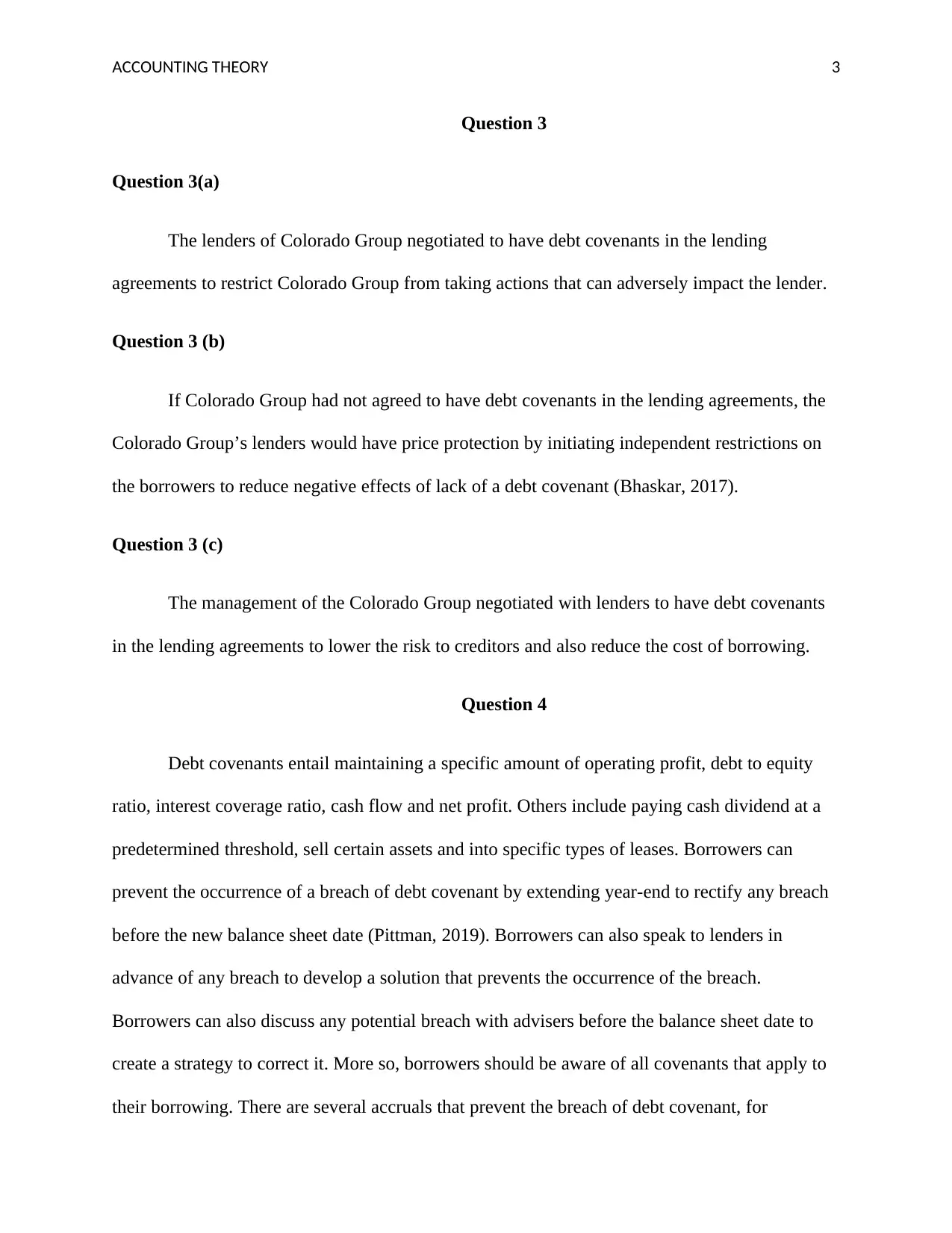
ACCOUNTING THEORY 3
Question 3
Question 3(a)
The lenders of Colorado Group negotiated to have debt covenants in the lending
agreements to restrict Colorado Group from taking actions that can adversely impact the lender.
Question 3 (b)
If Colorado Group had not agreed to have debt covenants in the lending agreements, the
Colorado Group’s lenders would have price protection by initiating independent restrictions on
the borrowers to reduce negative effects of lack of a debt covenant (Bhaskar, 2017).
Question 3 (c)
The management of the Colorado Group negotiated with lenders to have debt covenants
in the lending agreements to lower the risk to creditors and also reduce the cost of borrowing.
Question 4
Debt covenants entail maintaining a specific amount of operating profit, debt to equity
ratio, interest coverage ratio, cash flow and net profit. Others include paying cash dividend at a
predetermined threshold, sell certain assets and into specific types of leases. Borrowers can
prevent the occurrence of a breach of debt covenant by extending year-end to rectify any breach
before the new balance sheet date (Pittman, 2019). Borrowers can also speak to lenders in
advance of any breach to develop a solution that prevents the occurrence of the breach.
Borrowers can also discuss any potential breach with advisers before the balance sheet date to
create a strategy to correct it. More so, borrowers should be aware of all covenants that apply to
their borrowing. There are several accruals that prevent the breach of debt covenant, for
Question 3
Question 3(a)
The lenders of Colorado Group negotiated to have debt covenants in the lending
agreements to restrict Colorado Group from taking actions that can adversely impact the lender.
Question 3 (b)
If Colorado Group had not agreed to have debt covenants in the lending agreements, the
Colorado Group’s lenders would have price protection by initiating independent restrictions on
the borrowers to reduce negative effects of lack of a debt covenant (Bhaskar, 2017).
Question 3 (c)
The management of the Colorado Group negotiated with lenders to have debt covenants
in the lending agreements to lower the risk to creditors and also reduce the cost of borrowing.
Question 4
Debt covenants entail maintaining a specific amount of operating profit, debt to equity
ratio, interest coverage ratio, cash flow and net profit. Others include paying cash dividend at a
predetermined threshold, sell certain assets and into specific types of leases. Borrowers can
prevent the occurrence of a breach of debt covenant by extending year-end to rectify any breach
before the new balance sheet date (Pittman, 2019). Borrowers can also speak to lenders in
advance of any breach to develop a solution that prevents the occurrence of the breach.
Borrowers can also discuss any potential breach with advisers before the balance sheet date to
create a strategy to correct it. More so, borrowers should be aware of all covenants that apply to
their borrowing. There are several accruals that prevent the breach of debt covenant, for
⊘ This is a preview!⊘
Do you want full access?
Subscribe today to unlock all pages.

Trusted by 1+ million students worldwide
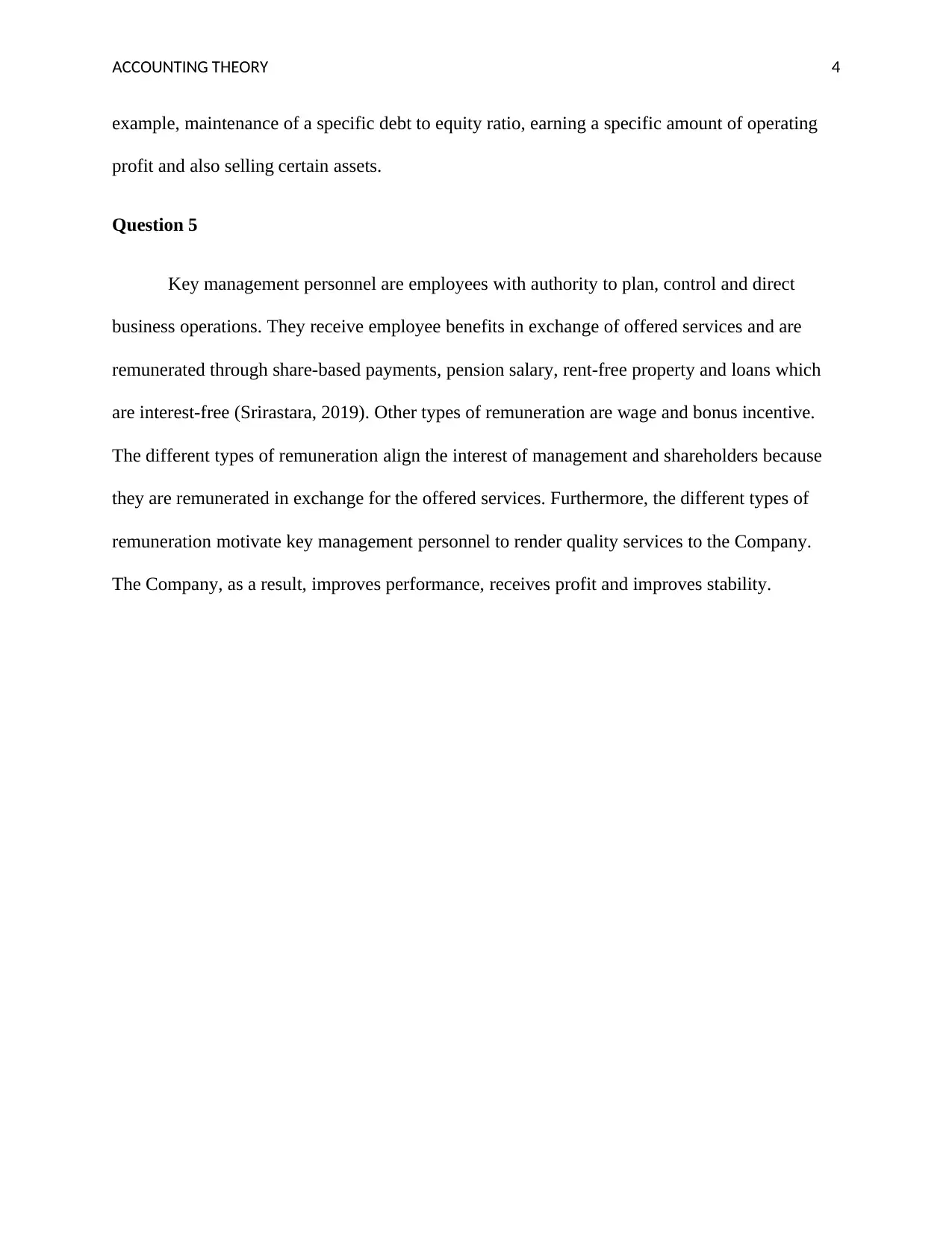
ACCOUNTING THEORY 4
example, maintenance of a specific debt to equity ratio, earning a specific amount of operating
profit and also selling certain assets.
Question 5
Key management personnel are employees with authority to plan, control and direct
business operations. They receive employee benefits in exchange of offered services and are
remunerated through share-based payments, pension salary, rent-free property and loans which
are interest-free (Srirastara, 2019). Other types of remuneration are wage and bonus incentive.
The different types of remuneration align the interest of management and shareholders because
they are remunerated in exchange for the offered services. Furthermore, the different types of
remuneration motivate key management personnel to render quality services to the Company.
The Company, as a result, improves performance, receives profit and improves stability.
example, maintenance of a specific debt to equity ratio, earning a specific amount of operating
profit and also selling certain assets.
Question 5
Key management personnel are employees with authority to plan, control and direct
business operations. They receive employee benefits in exchange of offered services and are
remunerated through share-based payments, pension salary, rent-free property and loans which
are interest-free (Srirastara, 2019). Other types of remuneration are wage and bonus incentive.
The different types of remuneration align the interest of management and shareholders because
they are remunerated in exchange for the offered services. Furthermore, the different types of
remuneration motivate key management personnel to render quality services to the Company.
The Company, as a result, improves performance, receives profit and improves stability.
Paraphrase This Document
Need a fresh take? Get an instant paraphrase of this document with our AI Paraphraser
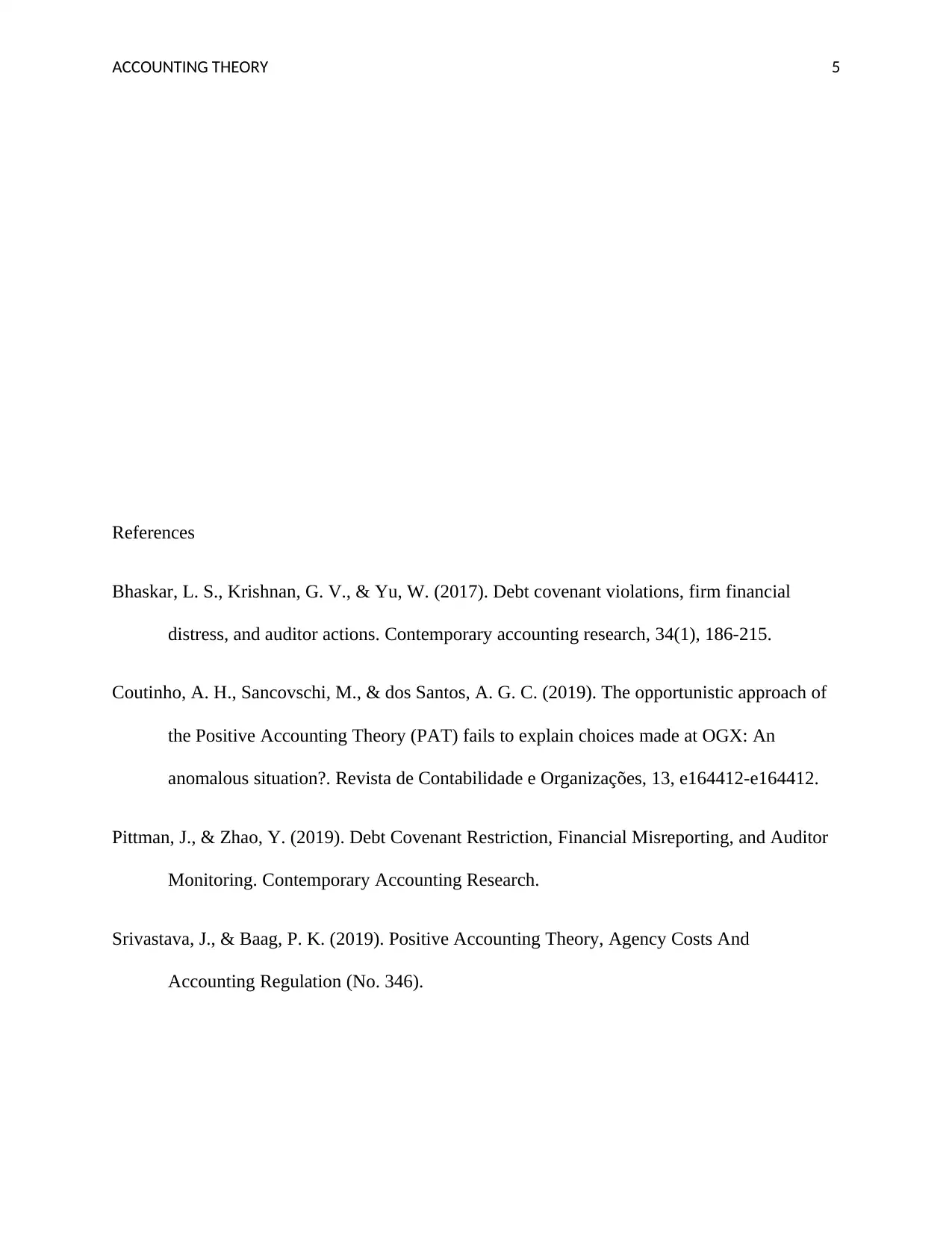
ACCOUNTING THEORY 5
References
Bhaskar, L. S., Krishnan, G. V., & Yu, W. (2017). Debt covenant violations, firm financial
distress, and auditor actions. Contemporary accounting research, 34(1), 186-215.
Coutinho, A. H., Sancovschi, M., & dos Santos, A. G. C. (2019). The opportunistic approach of
the Positive Accounting Theory (PAT) fails to explain choices made at OGX: An
anomalous situation?. Revista de Contabilidade e Organizações, 13, e164412-e164412.
Pittman, J., & Zhao, Y. (2019). Debt Covenant Restriction, Financial Misreporting, and Auditor
Monitoring. Contemporary Accounting Research.
Srivastava, J., & Baag, P. K. (2019). Positive Accounting Theory, Agency Costs And
Accounting Regulation (No. 346).
References
Bhaskar, L. S., Krishnan, G. V., & Yu, W. (2017). Debt covenant violations, firm financial
distress, and auditor actions. Contemporary accounting research, 34(1), 186-215.
Coutinho, A. H., Sancovschi, M., & dos Santos, A. G. C. (2019). The opportunistic approach of
the Positive Accounting Theory (PAT) fails to explain choices made at OGX: An
anomalous situation?. Revista de Contabilidade e Organizações, 13, e164412-e164412.
Pittman, J., & Zhao, Y. (2019). Debt Covenant Restriction, Financial Misreporting, and Auditor
Monitoring. Contemporary Accounting Research.
Srivastava, J., & Baag, P. K. (2019). Positive Accounting Theory, Agency Costs And
Accounting Regulation (No. 346).
1 out of 5
Your All-in-One AI-Powered Toolkit for Academic Success.
+13062052269
info@desklib.com
Available 24*7 on WhatsApp / Email
![[object Object]](/_next/static/media/star-bottom.7253800d.svg)
Unlock your academic potential
Copyright © 2020–2025 A2Z Services. All Rights Reserved. Developed and managed by ZUCOL.


